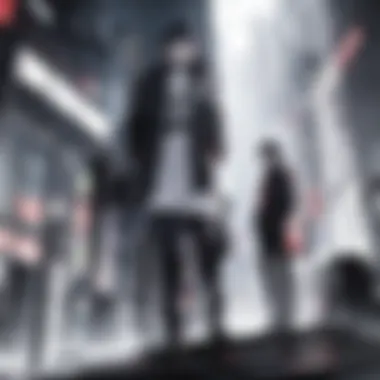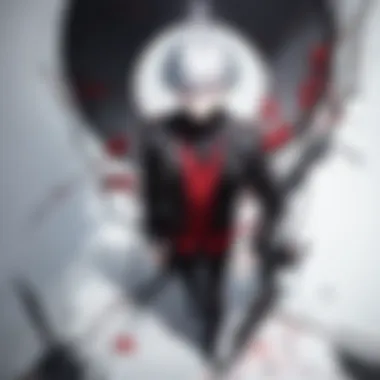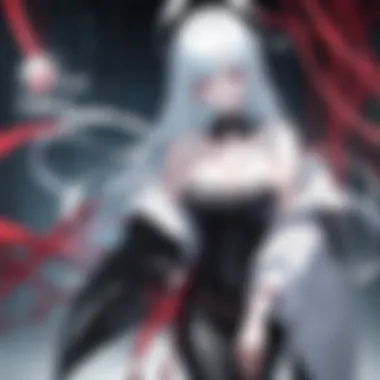A Comprehensive Analysis of Tokyo Ghoul's Debut Episode


Intro
Tokyo Ghoul's first episode serves as a powerful entry point into a complex world. This anime adaptation of Sui Ishida’s manga quickly establishes its dark atmosphere and complex themes. The purpose of this article is to dissect this opening episode meticulously, focusing on narrative structures, character introductions, and thematic significance.
Character Profiles
Overview of Main Characters
In exploring the characters introduced in the first episode, Ken Kaneki stands out as the primary protagonist. He is depicted as an ordinary college student whose life takes a drastic turn. The duality in his character is evident; he embodies both human fragility and the monstrous inclinations of ghouls.
Rize Kamishiro is another crucial character. Initially appearing as a charming and intriguing acquaintance, her true nature reveals a more sinister side. The interaction between Kaneki and Rize significantly shapes the story's narrative trajectory.
Supporting Characters
Supporting characters play a significant role in enriching the story. Touka Kirishima, a central supporting figure, is introduced as a waitress with a layered personality. Her complexity adds depth to the show and sets the stage for future developments. Other characters, such as Shuu Tsukiyama and Nishiki Nishio, contrast Kaneki’s journey and further illustrate the struggles faced by those in the world of ghouls.
Theme Exploration
Central Themes
The first episode presents various themes, including survival, identity, and humanity. Survival takes precedence as characters navigate a dangerous world where predator and prey roles are distinctly blurred. This struggle leads to questions about identity, particularly for Kaneki, as he grapples with his newfound existence.
Cultural References
Tokyo Ghoul integrates elements of Japanese culture, particularly in its depiction of urban life. The show references societal issues, like alienation and the struggle for acceptance. These elements enhance the narrative, offering commentary on contemporary culture while immersing viewers in a relatable yet frightening reality.
Popular Series and Recommendations
Top Anime Series of the Year
For viewers captivated by Tokyo Ghoul, exploring similar series can deepen the experience. Titles such as Attack on Titan and Death Note offer engaging narratives and complex characters that resonate with fans of darker themes.
Hidden Gems in Manga
In addition to anime, manga like Parasyte and Ajin provide rich stories that echo the themes found in Tokyo Ghoul. These works can enhance understanding and appreciation of the grotesque yet fascinating world Sui Ishida created.
"Tokyo Ghoul speaks to the hidden struggles within us, mirrored through its characters and settings."
This examination aims to highlight the core aspects that make the first episode a compelling foundation for understanding Tokyo Ghoul. By exploring characters and themes, we gain insights into not just the story, but also what it reflects about humanity.
Preface to Tokyo Ghoul
The introduction of Tokyo Ghoul serves an essential purpose in guiding readers into the intricate world created by Sui Ishida. This section sets the stage for understanding the anime's core elements, offering insights into its narrative complexity and impactful themes. An exploration of the series overview and the background of the creator provides a solid foundation for what follows in the subsequent sections.
Overview of the Series
Tokyo Ghoul debuted as a manga in 2011 and quickly transitioned into an anime adaptation in 2014. It presents a dark narrative set in a modern Tokyo where ghouls, creatures who consume human flesh, co-exist with humans unbeknownst to the latter. The protagonist, Kaneki Ken, undergoes significant transformations throughout the series, grappling with his new identity as a half-ghoul. This duality is central to the plot and reflects broader themes of self-discovery and societal marginalization.
The series has garnered substantial attention for its intricate storytelling and moral complexities. It navigates the blurred lines between right and wrong, challenging viewers to reconsider their perceptions of humanity and monstrosity. Understanding these elements adds depth to one's viewing experience, allowing for a richer engagement with the material.
Background of the Creator
Sui Ishida, the creative force behind Tokyo Ghoul, was inspired by various aspects of life and culture when crafting this series. Born in 1986, Ishida started drawing from a young age and continuously honed his style. Ishida's experiences and perspectives are evident in the narrative depth and character development found within Tokyo Ghoul.


Before achieving mainstream success with Tokyo Ghoul, Ishida worked on other manga projects, gaining necessary experience in storytelling and art. His ability to blend horror elements with philosophical questions about existence makes his work stand out in the anime and manga community. Moreover, Ishida's meticulous world-building sets up a nuanced exploration of themes that resonate deeply with audiences today.
"The distinction between humans and ghouls reflects society’s struggle with identity and belonging.”
Through this introduction, both new and returning fans can appreciate Tokyo Ghoul not just as a form of entertainment but as a significant cultural commentary. This depth of understanding makes it vital when analyzing the series and its impact.
Setting the Scene
Setting the scene is a crucial aspect of any narrative, particularly in anime like Tokyo Ghoul. The first episode lays the groundwork for what is to come. It introduces viewers not just to characters but also to the environment and the rules that govern this world. An effective setting enhances the overall viewer experience by immersing them deeply into the storyline.
Tokyo as the Primary Locale
Tokyo serves as more than just a backdrop; it is a living entity within Tokyo Ghoul. The city’s dark and gritty aesthetic reflects the internal struggles faced by characters. The viewer witnesses a bustling metropolis filled with diverse cultures contrasted sharply with the underlying threat from ghouls. This duality illustrates the complexity of both the human and ghoul worlds.
- Urban Density: The crowded streets signify a sense of isolation among individuals, a theme central to Kaneki’s journey.
- Contrasting Environments: The bright cafes where humans gather juxtapose the shadowy alleys that ghouls inhabit, emphasizing danger lurking beneath normalcy.
The depiction of Tokyo as vibrant yet perilous adds to the show's depth, drawing viewers into its narrative.
World-Building Elements
World-building is a central focus in Tokyo Ghoul, achieving a balance between reality and the fictional. This episode includes essential elements that construct the series’ unique universe. The established lore about ghouls and their interaction with society sets the stage for imminent conflict.
- Ghouls Defined: They are not merely monsters but beings with complex motivations, which complicates the moral landscape.
- Societal Norms: Understanding the coexistence of ghouls and humans allows the audience to grasp the stakes involved in the ensuing drama.
Furthermore, visuals play a substantial role in this world-building. Scenes transition from bright and lively settings to dark, eerie visuals, underpinning the theme of survival. The visual cues given in the first episode create a foundation for future revelations, as viewers learn about the laws governing ghouls and humans.
In (Tokyo Ghoul), the environment is an active participant in the story, reflecting the emotional currents within the narrative itself.
Character Preludes
Character introductions are critical in shaping the viewing experience of anime series. In the realm of Tokyo Ghoul, the characters serve not only as conduits for action but also as essential vehicles for thematic exploration. Each character's background and motivations enrich the narrative, allowing viewers to engage on multiple levels. As we delve into the introductions of key figures in the first episode, it becomes clear how the creators establish a foundation for emotional investment and narrative complexity early on. The contrasts and conflicts among characters set the stage for overarching themes, such as identity and transformation.
Kaneki Ken: The Protagonist
Kaneki Ken emerges as the central figure, providing a lens through which the audience explores the complexities of the Tokyo Ghoul universe. Initially presented as a timid college student, he embodies an ordinary individual thrust into extraordinary circumstances. The transformation he undergoes becomes significant, not merely as a plot twist but as a catalyst for discussions on identity and existential dilemmas. Kaneki's immediate struggle reflects a common human experience—the search for self amid overwhelming confusion. His interactions with supporting characters further define his persona, highlighting the nuances of his character development.
Rize Kamishiro: The Antagonist
Rize Kamishiro serves as a striking counterpoint to Kaneki. As the antagonist, her character introduces elements of horror and moral ambiguity. The initial encounter between Kaneki and Rize forces viewers to grapple with the unsettling nature of predation and trust. Rize embodies the duality of desire and danger, captivating audiences through her charm while instilling dread. This complex portrayal of the antagonist enables deeper discussions about the nature of evil and the circumstances that shape one's morality. Rize’s role in the story ultimately ignites the series’ central conflict, underscoring the precarious balance between human and ghoul society.
Supporting Characters
The supporting characters in Tokyo Ghoul provide additional layers of depth to the narrative. Important figures like Hideyoshi Nagachika and the members of the Anteiku café not only enrich Kaneki's journey but also reflect various perceptions of ghouls and humans. Hide serves as Kaneki's friend, representing loyalty and the emotional ties that tether Kaneki to his previous life. Meanwhile, the other characters introduce a spectrum of beliefs, challenges, and moral questions. Their inclusion enhances the storyline, contributing to the overarching themes of survival and humanity.
Collectively, the character introductions in the first episode of Tokyo Ghoul lay a well-crafted framework for the series. By establishing complex characters early on, the anime invites viewers to critically engage with its deeper meanings.
Plot Summary of the First Episode
The plot summary of the first episode of Tokyo Ghoul serves as a critical tool in understanding the narrative's foundation. This summary not only conveys the sequence of events but also highlights key character interactions and themes that will recur throughout the series. The importance of this narrative structure lies in its ability to introduce viewers to a complex world where the mundane collides with the horrifying. This episode establishes a groundwork for the philosophical and moral dilemmas that will be explored later. It is essential for fans and analysts alike to appreciate how this episode functions as both a standalone introduction and a prelude to a deeper narrative.
Key Events
In the inaugural episode, various significant events set the tone for the series. Central to the plot is the introduction of Kaneki Ken, a college student whose life drastically changes after a fateful encounter with Rize Kamishiro, a ghoul disguising herself as a human. Their meeting escalates quickly from an innocuous date to a gruesome near-death experience. During this chaotic sequence, Rize reveals her true nature by attempting to devour Kaneki. In a twist of fate, he survives but is left grievously wounded.


His transformation begins when he receives an organ transplant from Rize, turning him into a half-ghoul. This metamorphosis serves as a crucial turning point; it divides his existence into "before" and "after". As Kaneki grapples with his new identity, he becomes entangled in the conflict between humans and ghouls. The episode effectively showcases how ordinary life can dissipate in a moment, thrusting individuals into a world where survival hinges on navigating formidable boundaries.
Notable Scenes
Several scenes in the first episode leave a lasting impact on viewers. One particularly notable moment occurs during the restaurant scene, where Kaneki’s innocent interactions sharply contrast with the inherent brutality of the ghouls. This juxtaposition of normalcy amidst horror emphasizes the existential themes that permeate the series.
Another significant scene involves Kaneki's internal struggle after the transplant. As he lies in the hospital, there is a palpable sense of fear and confusion. He contemplates his life and the sudden shift to a reality involving ghouls, forcing the audience to engage with his turmoil. The use of visual storytelling here, particularly in the animation that illustrates Kaneki's emotions, enhances the viewers' connection to his plight.
"In a world where the monstrous often masquerades as human, the thin line between predator and prey becomes blurred."
These scenes encapsulate the overarching themes of identity and survival, while also enhancing character depth. By delineating Kaneki's journey and the chaos surrounding him, the first episode establishes the series' emotional weight and philosophical inquiries that will prevail throughout Tokyo Ghoul. Understanding these pivotal moments aids in grasping the subtleties of Kaneki's character arc as he navigates the morally gray territory ahead.
Themes Presented
The themes explored in the first episode of Tokyo Ghoul play a crucial role in understanding the narrative depth and emotional weight of the series. The introduction of heavy thematic elements sets the stage for character development and plot progression. These themes not only offer a reflection on the human condition but also present a complex dialogue on societal norms and individual identity. By analyzing these themes, we uncover the layers of meaning embedded in the story.
Identity and Transformation
Identity is a central theme in Tokyo Ghoul, prominently reflected in the character of Kaneki Ken. At the start, Kaneki is a typical human, navigating his daily life, which is filled with mundane experiences. However, his fateful encounter with Rize Kamishiro shatters this fragile sense of normalcy. The transformation he undergoes from human to ghoul is not just physical but also deeply psychological. This metamorphosis raises questions about what it means to be human.
Kaneki's struggle to accept his new identity embodies the broader conflict many individuals face when forced to confront aspects of themselves they do not recognize or accept. The dichotomy between his human past and ghoul present highlights the discomfort and confusion that often accompanies personal transformation.
Furthermore, the theme of identity is explored through other characters as well, such as Rize, who embodies the predator. Her role challenges Kaneki to not only adapt but also to understand the nature of those who inhabit the ghoul world. This duality enriches the narrative, prompting viewers to reflect on their perception of self in relation to others.
Survival and Humanity
The theme of survival is intricately tied to the character's journeys in Tokyo Ghoul. As the episodes unfold, it becomes evident that survival in this world comes with a deep moral cost. Every character, whether ghoul or human, is faced with choices that test their ethical beliefs. Kaneki, now a half-ghoul, grapples with the urge to preserve his humanity while also navigating the brutal instincts of the ghoul side.
This struggle leads to the exploration of what it means to be truly human amidst chaos. Characters are placed in situations where they must decide between fighting for their survival at the expense of others or seeking connections that potentially risk their lives. The brutal reality of the ghoul society serves as a metaphor for the survival instincts that can push humanity to the brink.
In a world where the line between predator and prey blurs, Tokyo Ghoul asks its audience to consider the essence of humanity itself.
The interplay between survival and humanity also reflects larger societal challenges. The show presents a commentary on how societal pressures and external threats can distort our moral compasses and redefine our identities. As viewers delve deeper into the series, they are beckoned to reconsider what it means to retain one's humanity in the face of overwhelming adversity.
The themes of identity and transformation, alongside survival and humanity, offer a rich tapestry for exploring the psyche and moral dilemmas of each character, making Tokyo Ghoul not just an action-packed anime, but a philosophical exploration as well.
Artistic Style and Animation
The artistic style and animation of Tokyo Ghoul serve as crucial elements in establishing the series' identity. Visual aesthetics not only contribute to the viewer's first impressions but also aid in the storytelling process. The choices made in character design and animation techniques create an atmospheric environment that immerses the audience in Kaneki's harrowing journey. In this section, we will explore how these aspects work together to enhance the narrative experience.
Character Design
Character design in Tokyo Ghoul plays a significant role in reflecting the psychological and emotional states of the characters. Kaneki Ken, the protagonist, is designed with a distinct appearance that signifies his unique journey. His initially ordinary look, characterized by his shaggy black hair and thin frame, gradually transforms, exhibiting the impact of his experiences. The visual shift in Kaneki's appearance marks significant moments in the plot.
Rize Kamishiro, representing the darker aspects of the series, features a more pronounced design with striking white hair and a predatory gaze. Her character design emphasizes her role as an antagonist. This contrast is intentional, highlighting the duality in the world – the horrified human and the monstrous ghoul.
- Key design elements include:
- Simplistic yet expressive facial features.
- Color palettes that reflect characters' personalities.
- Clothing styles that signify their roles in society.
Through these choices, the character designs resonate with the audience, making them more relatable, and enhancing their investment in the storyline.
Visual Storytelling Techniques


The use of visual storytelling techniques in the first episode of Tokyo Ghoul is noteworthy. The series employs a mix of dynamic animation and careful framing to convey emotions without relying excessively on dialogue. Key scenes are often defined by powerful, expressive visuals that capture the essence of the characters’ experiences.
One effective technique is the change in pacing during important moments. For instance, the transition from fast-paced action scenes to slower, more savored moments reflects Kaneki's internal struggles. With this method, viewers comprehend the weight of his choices and experiences.
Additionally, the mixture of bright colors and dark shadows creates a gloomy ambiance, amplifying the overarching themes of survival and identity. The animation maintains a balance between the grotesque and the beautiful, keeping the audience engaged.
"The art style is not just a medium; it is part of the narrative fabric of the series."
Soundtrack Analysis
The soundtrack of a series plays a crucial role in shaping the viewer's experience. In Tokyo Ghoul, the audio elements enhance the emotional weight of scenes and reveal character depth. The music works in tandem with the narrative to create a profound atmosphere that draws the audience into Kaneki's world. The careful selection of musical pieces is deliberate and serves multiple purposes, such as establishing tone, highlighting themes, and providing a sense of continuity throughout the episode.
Opening Theme
The opening theme of Tokyo Ghoul, titled "Unravel" by TK from Ling Tosite Sigure, resonates deeply with the show's core themes. It begins with a haunting melody that captures the struggle and duality present in Kaneki's character. The lyrics explore feelings of alienation, a key aspect of the protagonist’s journey, encouraging viewers to reflect on their own identities. This connection between the music and the narrative sets a stark tone, preparing the audience for the emotional and psychological battles that lay ahead.
The animation accompanying the opening at times showcases contrasting imagery, such as dichotomies of light and dark, which parallels Kaneki's internal conflict. The choice of colors and visuals paired with the music enhances the overall impact. As viewers, we are drawn into a complex world where beauty and horror coexist, making the opening theme an integral part of the storytelling process.
Background Music and Sound Effects
Background music and sound effects are meticulously crafted in Tokyo Ghoul, amplifying important moments throughout the first episode. The score fluctuates between anxiety-inducing sounds during tense scenes and softer melodies that provide moments of introspection. For instance, the quiet moments of Kaneki's daily life are often underscored by gentle music, which allows audiences to feel connected to him before the chaos ensues.
Additionally, the sound effects play an essential role in conveying the horror elements present in the story. The chilling sounds associated with ghouls, such as growls or unsettling whispering, serve as reminders of the impending danger. They heighten the suspense in scenes where Kaneki is in peril, ensuring that viewers remain engaged and on edge.
In summary, the soundtrack of Tokyo Ghoul—comprising its opening theme and carefully orchestrated background music—adds significant depth to the narrative. It enriches viewer experience by enhancing emotional resonance, establishing tone, and contributing to world-building.
"Music is the shorthand of emotion."
— Leo Tolstoy
Understanding the intricacies of the soundtrack invites us to appreciate its contribution beyond mere background noise. It is essential to how the story is experienced, elevating Tokyo Ghoul to a level where sound becomes an indispensable narrative device.
Impact on Anime Culture
The impact of Tokyo Ghoul on anime culture cannot be underestimated. This series has carved a unique space within the anime landscape, resonating deeply with audiences, critics, and creators alike. The intricate narrative, dark themes, and complex characters have pushed boundaries and changed the expectations of what anime can portray.
Critical Reception
Critics received the first episode of Tokyo Ghoul with a mix of intrigue and admiration. Many noted its ability to blend horror with philosophical undertones, prompting viewers to reflect on identity and morality in the face of unimaginable circumstances. Reviewers praised the show's production values, particularly its artistic style and animation. This episode was highlighted as a strong entry point into the series, showcasing Kaneki's transformation and the harrowing world he inhabits. However, some critiques arose regarding pacing, as some felt the story's introduction was hurried. Despite this, the overall consensus was overwhelmingly positive, establishing a platform for the series' future success.
"The first episode opens the door to complex themes and rich character development that will engage the viewers' minds well beyond the surface."
Fan Reception and Community Response
Fan reception was equally enthusiastic, with Tokyo Ghoul quickly cultivating a diverse community around it. Social media platforms like Reddit and Facebook saw increased discussions about the series' deeper meanings, especially concerning the struggle between humans and ghouls. Viewers often engaged in debates analyzing characters' motivations and ethical dilemmas presented in the episode. The fandom produced numerous fan arts, theories, and discussions that enriched the viewing experience. Online forums became a hub for fans to express their thoughts and share insights, showcasing a vibrant community that further fueled interest in the series.
In summary, Tokyo Ghoul did not just become another anime; it sparked conversations and inspired a new wave of content that sought to explore unconventional themes within storytelling, leaving a lasting mark on anime culture.
Closure
The conclusion of this article plays a critical role in synthesizing the insights gained from examining the first episode of Tokyo Ghoul. Throughout the analysis, we have uncovered essential elements of the series, including its unique narrative structure, character complexities, and significant themes. These insights not only enhance understanding but also provide a deeper appreciation for the artistry involved in anime.
Summary of Key Insights
In summary, the first episode serves as a robust foundation for the entire Tokyo Ghoul series. It introduces Kaneki Ken, a character undergoing profound transformation, thus setting the tone for his journey. Rize Kamishiro's role as the antagonist effectively establishes the immediate conflict. Themes of identity, survival, and humanity create emotional depth, prompting viewers to reflect on their own experiences. The artistic style, coupled with a captivating soundtrack, complements the storytelling and elevates the overall viewing experience.
Final Remarks on Series Evolution
As Tokyo Ghoul progresses, the evolution of characters and themes becomes more pronounced. The complexities of identity shift and deepen as Kaneki faces new challenges. What begins as a struggle for survival evolves into a broader contemplation of what it means to be human. Fans and critics alike recognize the series not solely for its horror elements but for its existential inquiries. The legacy of the first episode is evident as it continues to resonate within the anime community, inspiring discussions and analyses that underscore its impact.
"The compelling narrative and intricate character development in Tokyo Ghoul offer a unique lens through which to explore profound themes of existence."







